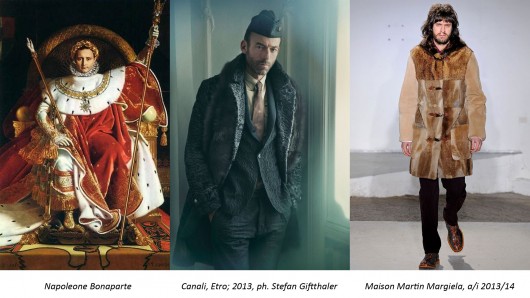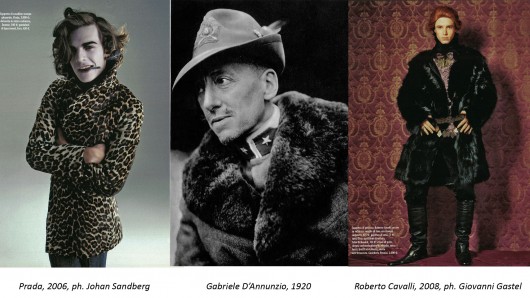VANITA’, IL TUO NOME E’ UOMO
Quando, nei secoli più bui del Medio Evo, gli abitanti di mezza Europa vedevano profilarsi all’orizzonte i drakkar – le agilissime navi vichinghe – cariche di uomini irsuti vestiti di pellicce di orso o di lupo, indubbiamente potevano focalizzare le loro menti su qualsiasi cosa fuorché sul concetto di vanità maschile. Sono passati oltre mille anni ed il rapporto tra uomo e pelliccia si è sviluppato, articolandosi in infinite valenze, senza accantonare quella primaria: coprire il corpo e riscaldarlo. In verità, nell’abbigliamento al maschile come in quello femminile, la pelliccia ha sempre giocato una pluralità di ruoli. Ha rappresentato il lusso, il desiderio di opulenza e di ostentazione, il compiacimento per la vanità e lo sfarzo. Soprattutto, ha messo in evidenza il potere di chi la indossava sino alla regalità, tramandando costantemente la sua simbologia, come un vero fil rouge che ha percorso ogni civiltà. I sovrani egizi, babilonesi, persiani, inca, maya, aztechi, gli imperatori romani prediligevano il vello degli animali più esotici, non di rado dei grandi felini – simbolo di forza ed invincibilità – utilizzandolo persino per adornare i loro cocchi. Nelle città rinate dopo l’anno 1000, mentre si affacciava al potere la nuova classe proto-borghese, proliferavano le leggi suntuarie per limitare l’ostentazione da parte dei nouveaux riches. Anche la pelliccia era chiamata in causa, secondo regole precise che ne stabilivano tipologia e metraggi permessi in base al rango e al censo. La rivoluzione puritana di Cromwell in Inghilterra e le riforme calvinista e luterana nell’Europa centrale, hanno cambiato le carte in tavola: rigore e sobrietà assurgevano a valori etici assoluti.
Non per tutti, certo. Il clero cattolico e, soprattutto, l’aristocrazia, si sono auto-esentati dal rispetto di questa nuova morale. La storia dell’arte dell’era moderna è costellata di ritratti di re ed imperatori ammantati di pellicce: da Enrico VIII a Luigi XIV, le Roi Soleil, da Napoleone I a Ludwig II di Baviera. L’affermarsi dell’economia industriale ha rappresentato un’ulteriore svolta. Il ceto produttivo ha saldamente raggiunto il vertice del nuovo ordine sociale, rendendo superflua la necessità di dimostrarlo smaccatamente. La pelliccia, era più che sufficiente per i dettagli, o per gli interni. Solo i grandi magnati – Rockfeller, Vanderbildt, Krupp – continuavano ad osare la pelliccia intera. Oppure i dandy. Come Gabriele D’Annunzio, che completava le “uniformi” di sua creazione con elementi di uno sfarzo pari a quello dei potenti boiardi dell’epoca di Ivan il Terribile. Oggi la pelliccia ha ritrovato appieno il suo ruolo e lo può vivere con una libertà prima impensabile. Sostanzialmente per tre ragioni: ha finalmente smesso di essere uno status symbol; non è più chiamata a rappresentare il potere; l’innovazione tecnologica l’ha resa infinitamente più duttile, facendone un materiale privilegiato per ogni tipo di sperimentazione. Rovesciando un ordine millenario, è diventata manifestazione di ribellione e di stravaganza insieme: l’hanno indossata Jim Morrison, Elton John, Liberace. Oppure di disinvoltura. Già a metà degli anni ’50 Re Olav di Norvegia – il “Re del popolo” che raggiungeva le piste da sci in metropolitana, come tutti gli abitanti di Oslo – nel tempo libero indossava una pelliccia non tanto dissimile da quelle dei sui antenati predatori. Understatement scandinavo e royal chic. Giorgio Re
Vanity, your name is Man. When, during the darkest centuries of the Middle Age, the inhabitants of a half of Europe saw the drakkar – the double-quick viking ships – stand out against the horizon, laden of hairy men dressed with fur from bears or wolves, surely didn’t think about male vanity. A thousand years have passed by, and the relationship between men and furs has grown, structuring itself in a range of uses, without forgetting the original one: covering and warming the human body. Actually, in menswear as well as in womenswear, the fur has played a multiplicity of roles. It represented luxury, desire of opulence and ostentation, satisfaction related to vanity and splendour. Above all, it enlighted the power of who wore it up to regality, costantly passing down its symbolism like a real fil rouge through every culture. The kings of Egyptians, Babylonian, Persian, Incas, Mayan, Aztec, as well as Roman emperors, preferred the most exotic animals’ fleece, for examples of giant felines – symbol of strenght and invincibility – and they used it even for decorating their coaches. In reborn cities after 1000 A.D., while the first “middle-class” was approaching to power, there were a lot of luxury laws, made to limit the ostentation by the nouveaux riches. There were laws about furs too, that established variety and yardage allowed on the basis of rank and census. The Cromwell puritan revolution in England and the calvinist and luteran reforms in Central Europe, changed the game: strictness and chasteness were the absolute ethical values. Surely not for all. The Catholic clergy and, above all, the aristocracy, were self-dispensed with the observance of this new moral. Art history in the modern era is full of portraits of kings and emperors bounded in furs: from Henry VIII to Louis XIV, le Roi Soleil, from Napoleon I to Ludwig II of Bavaria. The industrial economy establishment represented an additional turning point. The manufacturing class firmly reached the top of the new social order, making the necessity of excessive demonstrations redundant. The fur was more than enough for details or lining. Only great magnates – Rockfeller, Vanderbildt, Krupp – kept on daring the fur coat. Or the dandies. Like Gabriele D’Annunzio, who adorned his “uniforms” with details so luxurious to be compared with the uniforms of the Eastern Europe’s aristocracy during the Ivan the terrible era. Today fur has fully recovered its role in a new free dimension. For three reasons: it has finally stopped being a status symbol; it’s not a power icon anymore; the technological innovation made it infinitely more adaptable to every kind of experimentation. Reversing a millenial order, it has become expression of both rebellion and extravagance: it’s been worn by Jim Morrison, Elton John, Liberace. Or of self-confidence. In the middle fifties King Olav of Norway – the “King of the people” that reached the ski slopes on the subway, just like the other inhabitants of Oslo – in his free time used to wear a fur coat like those worn by his predator forefathers. Scandinavian understatement and royal chic. Giorgio Re







